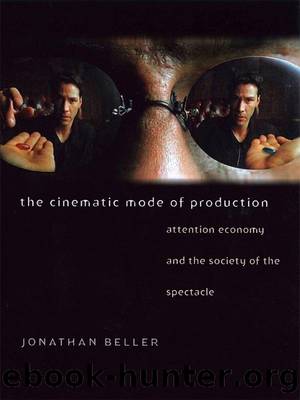The Cinematic Mode of Production (Interfaces: Studies in Visual Culture) by Jonathan Beller

Author:Jonathan Beller [Beller, Jonathan]
Language: eng
Format: mobi
Publisher: University Press of New England
Published: 2012-05-28T16:00:00+00:00
* * *
The Scopic, or, the Agency of the Visual Object
We have begun to observe the crises that the technological development of the image represents for language, for the order of representation. The “noise” of the image on language links the emergence of the unconscious with the visual, and, as I shall further elaborate, it is the visual that provides the basis of Lacan’s ocularcentric theory of the subject. In the work of Lacan, the struggle of the symbolic with the unconscious is founded on the struggle of the symbolic with the visual. It should be noted that Lacan studies Freud’s unconscious, which emerges, coincidentally, with cinema. This unconscious, which in Freud first appears as ruptures in language, in Lacan’s analysis is derived scopically.
In the latter half of The Four Fundamental Concepts of Psychoanalysis, one may grasp that the subject as an effect of the signifier is transposed from a visual relation. Citing Merleau-Ponty, Lacan specifies that in terms of our being (as distinct from our function as subject), “we are beings who are looked at in the spectacle of the world. That which makes us consciousness institutes us by the same token as speculum mundi” (FFCP, 75). Having specified the mise-en-scène of human being, Lacan immediately introduces an important qualification: “The world is all-seeing, but it is not exhibitionistic—it does not provoke our gaze. When it begins to provoke it, the feeling of strangeness begins too. What does this mean, if not that in the so-called waking state there is an elision of the gaze, and an elision of the fact that not only does it look, it also shows. In the field of the dream, on the other hand, what characterizes the image is that it shows” (FFCP, 75). The emphasis here is on a certain bivalence of the gaze that Lacan will develop at some length. We are seen in the world, but it is only with the inauguration of our seeing that the dialectics of subjectivity emerge. For Lacan, the bivalence of seeing is embodied in a split between being and meaning, the eye and the gaze. “In so far as I am under the gaze, Sartre writes, I no longer see the eye that looks at me and if, I see the eye, the gaze disappears” (FFCP, 84).
The point is that this involution of the eye and the gaze introduces into perception an imaginary dimension. In Sartre’s example, there is a demonstrable oscillation, “when I am under the gaze, I no longer see the eye,” that is, I imagine being looked at by the Other and in doing so perceive myself as seen. “If I see the eye, the gaze disappears,” that is, when I look, when I see the eye as an object or image, I do not see (that I am seen). In each direction, as it were, of this fundamental dynamic between self and Other, something is missed. The imaginary element (the point from which I am seen) is in the field of the Other.
Download
This site does not store any files on its server. We only index and link to content provided by other sites. Please contact the content providers to delete copyright contents if any and email us, we'll remove relevant links or contents immediately.
The Kite Runner by Khaled Hosseini(5070)
Gerald's Game by Stephen King(4565)
Dialogue by Robert McKee(4315)
The Perils of Being Moderately Famous by Soha Ali Khan(4162)
The 101 Dalmatians by Dodie Smith(3446)
Story: Substance, Structure, Style and the Principles of Screenwriting by Robert McKee(3389)
The Pixar Touch by David A. Price(3353)
Confessions of a Video Vixen by Karrine Steffans(3234)
How Music Works by David Byrne(3166)
Fantastic Beasts: The Crimes of Grindelwald by J. K. Rowling(2985)
Harry Potter 4 - Harry Potter and The Goblet of Fire by J.K.Rowling(2981)
Slugfest by Reed Tucker(2930)
The Mental Game of Writing: How to Overcome Obstacles, Stay Creative and Productive, and Free Your Mind for Success by James Scott Bell(2840)
4 - Harry Potter and the Goblet of Fire by J.K. Rowling(2645)
Screenplay: The Foundations of Screenwriting by Syd Field(2567)
The Complete H. P. Lovecraft Reader by H.P. Lovecraft(2505)
Scandals of Classic Hollywood: Sex, Deviance, and Drama from the Golden Age of American Cinema by Anne Helen Petersen(2459)
Wildflower by Drew Barrymore(2434)
Robin by Dave Itzkoff(2374)
